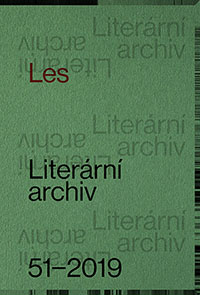Symbolika lesa (a zvláště břízy) v díle Aloise Kalvody
Forest Symbolism (Particularly the Birch Tree) in the Works of Alois Kalvoda
Author(s): Pavel ŠtěpánekSubject(s): Visual Arts, History of Art
Published by: Památník národního písemnictví
Keywords: Alois Kalvoda;birch;forest;symbolism;landscape painting;
Summary/Abstract: Landscapes with birch trees were among the new subject matter taken up by young artists in the late nineteenth and the early twentieth century. Perhaps it was a residue of the delicate pastoral romanticism of the eighteenth century. The decorative effect of this tree first fascinated a number of painters, including Antonín Mánes (1784‒1843) and Julius Mařák (1835‒1899), and a number of the latter’s pupils, those he taught directly or those who came afterwards. It seems that almost all artists went through the ‘birch period’, as it was called at the time. Because of these ‘rehashes’, even today we sense in birch-tree paintings something almost kitschy, the absence of firm belief, and vagueness. In its day, however, when first making its way onto canvases and prints, this symbol was understood differently. In the thinking of the period it was a symbol that was in essence Germanic and Slavonic (in southern Europe, the birch is rare); in central and northern Europe, it was a symbol of spring and of the power of awakening life; it was used as a magical means of winning someone’s love and for divination; in short, the birch corresponded to fin-de-siècle moods. One of the most frequent interpreters of this motif was the painter Alois Kalvoda (1875‒1934), following on from the landscape paintings of Mařák. Kalvoda demonstrates a painterly interpretation of various structures of the forest, even its motion (falling leaves). He made magnificent wide paintings, free of detail, with a fine structure of misty landscape in the background; for him the birch became an ‘attribute of character’, even an expression of patriotism. The motif of the birch forest appears even in his early works and then fully in Birch Grove (today at GASK in Kutná Hora). Kalvoda develops his skill of impressionistic representation of the play of light of the sky shining through trees and the reflection of light on leaf-covered ground. It is here that we see both the symbolic and the technical level of the interpretation of the forest, which remained with him throughout his life.
Journal: Literární archiv
- Issue Year: 2019
- Issue No: 51
- Page Range: 78-99
- Page Count: 22
- Language: Czech

